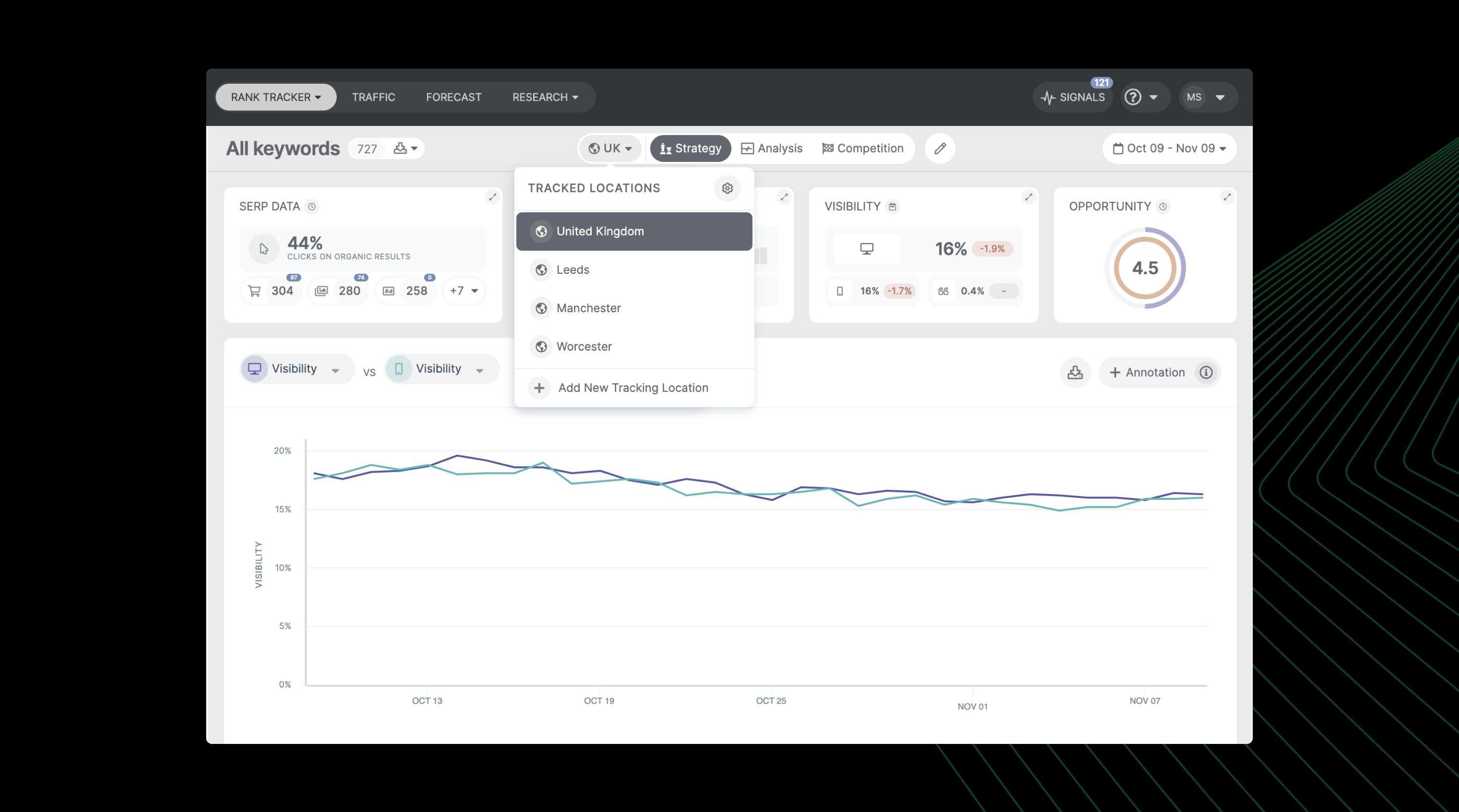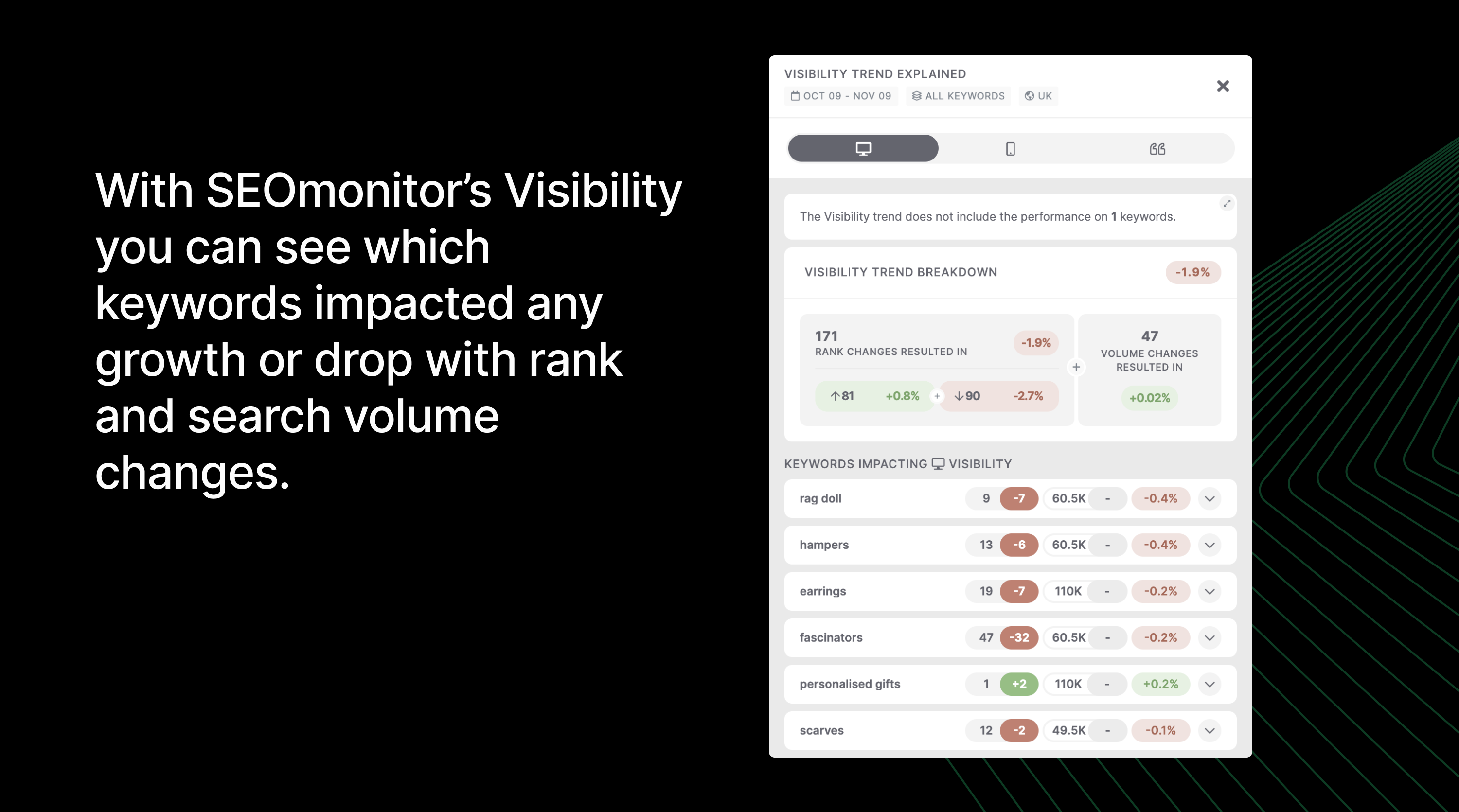Framework 1: Gain Control By Supporting Centralization & Consistency Across Every Brand/Market Mix
You need to have control over all levels:
- Brand level: Plan to highlight all common opportunities across markets to inform central brand strategies and prioritization.
- Market level: Aim to show specific category performance and understand where to maximize performance by minimizing cannibalization between audiences.
- Full central view across brand/market combinations: Coordinate to show macro-level insights that will aid in driving overall client direction and support decision-making on budgeting and prioritization.
These levels need to reflect in reporting, as they are critical to developing any global SEO operational framework.
“In our setup phase, we’ve created monthly dashboards automated with performance data from Google Search Console and SEOmonitor, which get delivered to central clients and local markets as emails with insights. SEOmonitor facilitates free, unlimited API access integration as well as Data Studio connectors for all the critical data of your SEO campaigns. As 80% of our report’s outputs are Data Studio based, this integration was crucial from the start.
These reports include keyword checks across defenses and conquests, highlighting key changes in performance and where additional optimization or review should be considered or actioned.”
-
 Image by SEOmonitor, November 2022
Image by SEOmonitor, November 2022
“You should also think about leveraging automation to scale highly labor-intensive work more effectively.
For keyword segmentation and clustering, we’ve made full use of SEOmonitor’s smart grouping functionality, which allows you to automatically organize keyword lists based on a variety of metric combinations and filters. These smart groups constantly refresh and update based on those filters, so you’re always up to date with targeted changes and insights.”
Framework 2: Maintain SEO Campaign Flexibility So You Cater To Local Market Nuances Where Audiences Behave Differently
It’s true that a standardized approach to SEO helps you act on common issues and opportunities while scaling the bulk of your technical SEO work.
But there is no denying that some markets will show a very different picture from others in terms of current visibility, site content, and brand awareness.
You need to leverage those differences through local search data and intent signals integrated into your content workflow and overall SEO strategy.
“This allows us to centralize SEO actions at scale whilst we tailor outputs to local nuances, market conditions, and available opportunities,” Raluca explains.
With this approach, you get to have a deeper understanding of the opportunity available in all markets in relation to the demand and the competition. Thus, you’ll be able to prioritize markets and focus work at a regional level to ensure that these markets receive the right amount of support while designing the overall strategy toward cumulative growth.
“Delivering an SEO program across so many brands and markets within one client means working with huge sets of search data which need to be managed in the most effective way. That means saving time and ensuring we follow a standardized approach to our work.
SEOmonitor’s keyword grouping system is both flexible and easy to use when setting up campaigns across multi-market clients. Also, with the multilocation feature, the tool allows tracking keywords for different locations within the same client campaign.”
It’s important to have the right technical infrastructure to support that level of complexity.
-
 Image by SEOmonitor, November 2022
Image by SEOmonitor, November 2022
Framework 3: Better Integrate Media Efforts To Adopt A Unified Approach To Global Search
“In the current context where consumers don’t see a distinction between paid and organic search, we are looking to evolve SEO and PPC across all media channels, extending the experience to support ongoing activities and campaigns and drive additional leads and sales,” Raluca highlights.
A One Search, unified framework allows you to assess:
- Which terms you don’t need to bid on because you rank well organically.
- The savings and incremental reach opportunity from paid search.
- The ability to re-invest historically ‘wasted’ PPC budget on longer tail keywords for incremental volume, powered by Search Ads 360.
- Where you can improve the user journey to make traffic more efficient.
Here’s what Raluca and her team did to make the most of the one-search framework:
“Our initial One Search tests relied on pausing PPC spend across keywords with a consistent position 1 visibility and minimal/no PPC competition.
The results have been phenomenal: we have been able to drive 2x improvement in CTR with a minimal increase in CPC. This unified search approach allows us to then further maximize results with better efficiency in terms of resources. Plus, we can become more competitive within the SEO and paid search space leading to an increase in visits and conversions across all sites and demonstrating the value of an integrated approach to search when both channels are managed by the same agency.”
Framework 4: Grow & Benchmark All Target Markets Toward A Common Objective By Developing Search Maturity Roadmaps
Search maturity roadmaps across markets allow you to evaluate:
- How performance differs from one target market to another.
- The current maturity level of each market when it comes to critical aspects of SEO performance such as content, technical, reporting, paid integration, and automation.
That’s where a reliable visibility metric helps you create a realistic benchmark and assess the online “real estate” across markets:
“SEOmonitor’s visibility metric helped us set up a robust measurement framework in place, which has informed the maturity roadmaps. The visibility metric is particularly useful in understanding the client’s website’s current organic visibility across all brands and markets so you can benchmark it against set objectives and KPIs across both mobile and desktop. This, in turn, enables us to develop a deep understanding of the opportunity available in each market. With this in-depth analysis, we can prioritize markets and focus on a regional level with the right amount of effort and resources.”
-
 Image by SEOmonitor, November 2022
Image by SEOmonitor, November 2022
Easily Implement These 4 Global SEO Frameworks With SEOmonitor
When you manage SEO for multi-brand, multi-market clients, it’s critical to design effective frameworks that leverage both your strategic insights and the tech infrastructure at hand:
- You need full visibility at both the market level and across markets (macro level).
- You need to have an in-depth understanding of each market, each audience, and how SEO efforts look overall.
- You must leverage SEO tools and automation, plus create the most impact while being resource-efficient.
- You need to have standardized benchmarks, processes, and practices across the board while keeping differences in check.
As Tudose and her team at Performics have shown, you must design clear objectives and working frameworks from the start, while being flexible enough to account for variations.
There are many things that can go wrong, from cannibalization issues to contrary user patterns, so you must be in control at all times.
We’ve designed SEOmonitor so you can manage SEO campaigns at scale while having fresh data at your disposal — with daily ranks for mobile and desktop as standard. We believe it’s important to have the right level of data granularity so you can make decisions faster.
Plus, with SEOmonitor you own all your campaign data. That’s why you get unlimited access to API, exports, and integrations with Google Sheets and Data Studio.
We know it’s just as important to keep track of all changes, especially with large datasets, and that clients want compelling monthly reports with specific tracked KPIs.
Join us and hundreds of digital marketing agencies in our quest to create more transparency and accountability in the SEO industry. And scale efficiently.
